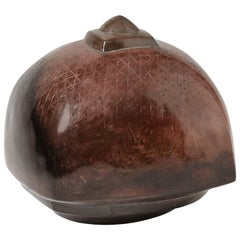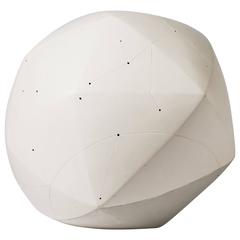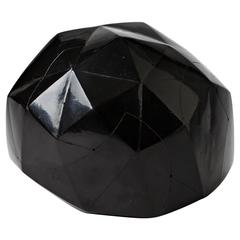Nadia Pasquer Folk Art
1
to
1
1
1
1
1
1
1
1
4
282
117
93
75
Creator: Nadia Pasquer
Ceramic Sculpture by Nadia Pasquer, 2010
By Nadia Pasquer
Located in Neuilly-en- sancerre, FR
A geometrical ceramic sculpture by Nadia Pasquer.
Artist monogram at the base, circa 2010.
Unique piece.
Perfect conditions.
Category
21st Century and Contemporary French Beaux Arts Nadia Pasquer Folk Art
Materials
Ceramic
Related Items
Maria H. Rahmer Figural Ceramic Sculpture
By Maria Rahmer
Located in New York, NY
Fabulous and large Maria H. Rahmer (1911-1998) figural sculpture of a boy holding fruit circa 1930s from Hungary. Great ceramic condition with signature H. Rahmer on the side of the ...
Category
1930s Hungarian Vintage Nadia Pasquer Folk Art
Materials
Ceramic
Ceramic Sculpture, Signed, circa 1970
By Tim Orr
Located in Saint-Ouen, FR
A ceramic sculpture signed at the base.
Perfect original conditions,
circa 1970.
Category
20th Century French Beaux Arts Nadia Pasquer Folk Art
Materials
Ceramic
Zoomorphic Ceramic Sculpture, Vase by Guerin, circa 1950
By Guerin
Located in Saint-Ouen, FR
A zoomorphic ceramic-sculpture- vase by Guerin.
Signed under the base.
Circa 1950-1960.
Category
20th Century French Beaux Arts Nadia Pasquer Folk Art
Materials
Ceramic
Zoomorphic Ceramic Sculpture by Pierre Roulot, circa 1960
By Pierre Roulot
Located in Saint-Ouen, FR
A zoomorphic ceramic sculpture by Pierre Roulot.
Perfect original conditions.
Signed under the base "Roulot".
circa 1950-1960.
Category
20th Century French Beaux Arts Nadia Pasquer Folk Art
Materials
Ceramic
Ceramic Sculpture of Abstract Cloud by Holly Curcio
Located in Phoenix, AZ
Holly Curcio is a ceramics artist from Massachusetts. She earned her MFA in ceramics from Arizona State University and her BFA in ceramics from the University of Massachusetts, Dartmouth. Curcio's abstract 'cloud' form whimsically plays with subtle color, texture and shape and was part of her solo exhibition "Suspending Disbelief," at Harry Wood...
Category
Early 2000s American Post-Modern Nadia Pasquer Folk Art
Materials
Ceramic
Big Ceramic Sculpture by Pierre Baey, circa 1990
By Pierre Baey
Located in Saint-Ouen, FR
A big ceramic sculpture by Pierre Baey.
Unique piece.
Perfect original conditions.
Circa 1990.
Category
20th Century French Beaux Arts Nadia Pasquer Folk Art
Materials
Ceramic
Big Ceramic Sculpture by Joelle Deroubaix to La Borne, circa 1960-1970
By Joelle Deroubaix
Located in Saint-Ouen, FR
A big ceramic sculpture by Joelle Deroubaix to La Borne.
Perfect original conditions.
Not signed.
Circa 1960-1970.
Category
20th Century French Beaux Arts Nadia Pasquer Folk Art
Materials
Ceramic
H 21.66 in W 11.03 in D 11.82 in
Large Ceramic Sculpture
Located in Munich, DE
Creative phantasy sculpture signed by the artist
Category
Mid-20th Century French Modern Nadia Pasquer Folk Art
Materials
Ceramic
Porcelain Sculpture by Wayne Fischer, 2007
By Wayne Fischer
Located in Saint-Ouen, FR
A porcelain sculpture by Wayne Fischer.
Perfect original conditions.
Signed.
Unique piece.
2007.
How can an inert object produce deeply unsuspecting, indecipherable, uncontrollable emotions?
Wayne Fischer is an artist who can create works that force one to ask such moving questions as this. If he doesn’t know why, if he can’t explain the deepest reasons of his artistic research, he definitely knows the workings and limitations of the artistic process he invented.
He has never deviated from the course he set for himself since university; translate life. The works presented here show the evolution of his creations over the past thirty years. If Wayne Fischer has received several international prizes and quickly obtained the recognition of his peers in ceramics, nevertheless he retains a singular position at once unavoidable and disturbing. His sculptures are paradoxical, powerful and sensual, and cause a certain unease. They are beautiful, carnal, touchable, all the while being outside the standard idea of beauty. The ambiguity of attraction and rejection is at the heart of this evolution.
The pieces from the 1980s and 90s are imposing by their size, stature and symmetry, which give them balance. They generate surprise, curiosity and play between contrasts that are both soft and aggressive. They reference the body, muscles, and torso, without presenting an exact reality. They are double-faced, seductive, and enigmatic. Wayne’s shapes are inspired by shells, bivalves, sometimes presented as though they are floating in space. But the reference of the marine world to the mysterious female body has only one interpretation and only history and emotion condition the reaction of the spectator: he accepts or refuses to see, to be seduced. He is touched or he flees.
The more recent sculptures are appreciated in the fullness of their round volume and the search for a pure universal beauty. “Metamorphosis,” the work recently awarded by the Bettencourt Foundation, is from this series of pieces wheel- thrown and deformed which pushes the porcelain from the inside so the bulges evoke the movement of waves or the musculature of several bodies. The exactness, the clean breaks, the assurance of lines and valleys are testimony to the interior power that governs the creation. The life energy expressed is also felt by the artist as the origin of ceramics. All the pieces are curved and tense. They show no marking, no sign of the hand, no imprints, and yet give an impression of spontaneity, as if a dropped piece of clay found its form by chance. Depending on the angles, the content becomes “the origins of the world”. Femininity and sensuality are exalted. Inspired by the body, before and after birth, or simply the sea, the parts of the sculpture conjugate around a mysterious interior cavity, secret and troubling. The interior wall doesn’t correspond to the exterior, and has its own volumes, deformities, and intimacy. The pieces present two kinds of interior: one open, and partially uncovered, the other totally hidden inside. The differences of their respective deformation reinforce the impression of life : the subjective representation of muscles and bones, of bulges pushed by an interior force, like a visceral movement of respiration. The surface of the ceramic is crackled but soft and fine, even reflecting light like the skin. The nuances of color reinforce the expression of sensuality.
The alignment of technique and what it causes one to see and feel has rarely been so intimately successful.
Wayne Fischer perfected his technique in the 1970s and has remained faithful to it. He adds fibers to porcelain clay that has been chosen for its whiteness to create and accentuate volume around empty space, by assembling slabs or thrown pieces. Then, he makes another piece that takes its place inside; both parts are formed with no hand...
Category
21st Century and Contemporary French Beaux Arts Nadia Pasquer Folk Art
Materials
Ceramic
Big Ceramic Sculpture with Black and Blue Glazes Decoration by Michel Lanos
By Michel Lanos
Located in Saint-Ouen, FR
A big ceramic sculpture with black and blue glazes decoration by Michel Lanos (1926-2005).
Perfect original decorations.
Artist signature under the base,
circa 1990.
Unique piece.
Category
20th Century French Beaux Arts Nadia Pasquer Folk Art
Materials
Ceramic
H 35.83 in W 6.3 in D 4.73 in
A porcelain sculpture by Wayne Fischer, 2022
By Wayne Fischer
Located in Saint-Ouen, FR
A porcelain sculpture by Wayne Fischer.
Perfect original conditions.
Signed.
Unique piece.
2022.
How can an inert object produce deeply unsuspecting, indecipherable, uncontrollable emotions?
Wayne Fischer is an artist who can create works that force one to ask such moving questions as this. If he doesn’t know why, if he can’t explain the deepest reasons of his artistic research, he definitely knows the workings and limitations of the artistic process he invented.
He has never deviated from the course he set for himself since university; translate life. The works presented here show the evolution of his creations over the past thirty years. If Wayne Fischer has received several international prizes and quickly obtained the recognition of his peers in ceramics, nevertheless he retains a singular position at once unavoidable and disturbing. His sculptures are paradoxical, powerful and sensual, and cause a certain unease. They are beautiful, carnal, touchable, all the while being outside the standard idea of beauty. The ambiguity of attraction and rejection is at the heart of this evolution.
The pieces from the 1980s and 90s are imposing by their size, stature and symmetry, which give them balance. They generate surprise, curiosity and play between contrasts that are both soft and aggressive. They reference the body, muscles, and torso, without presenting an exact reality. They are double-faced, seductive, and enigmatic. Wayne’s shapes are inspired by shells, bivalves, sometimes presented as though they are floating in space. But the reference of the marine world to the mysterious female body has only one interpretation and only history and emotion condition the reaction of the spectator: he accepts or refuses to see, to be seduced. He is touched or he flees.
The more recent sculptures are appreciated in the fullness of their round volume and the search for a pure universal beauty. “Metamorphosis,” the work recently awarded by the Bettencourt Foundation, is from this series of pieces wheel- thrown and deformed which pushes the porcelain from the inside so the bulges evoke the movement of waves or the musculature of several bodies. The exactness, the clean breaks, the assurance of lines and valleys are testimony to the interior power that governs the creation. The life energy expressed is also felt by the artist as the origin of ceramics. All the pieces are curved and tense. They show no marking, no sign of the hand, no imprints, and yet give an impression of spontaneity, as if a dropped piece of clay found its form by chance. Depending on the angles, the content becomes “the origins of the world”. Femininity and sensuality are exalted. Inspired by the body, before and after birth, or simply the sea, the parts of the sculpture conjugate around a mysterious interior cavity, secret and troubling. The interior wall doesn’t correspond to the exterior, and has its own volumes, deformities, and intimacy. The pieces present two kinds of interior: one open, and partially uncovered, the other totally hidden inside. The differences of their respective deformation reinforce the impression of life : the subjective representation of muscles and bones, of bulges pushed by an interior force, like a visceral movement of respiration. The surface of the ceramic is crackled but soft and fine, even reflecting light like the skin. The nuances of color reinforce the expression of sensuality.
The alignment of technique and what it causes one to see and feel has rarely been so intimately successful.
Wayne Fischer perfected his technique in the 1970s and has remained faithful to it. He adds fibers to porcelain clay that has been chosen for its whiteness to create and accentuate volume around empty space, by assembling slabs or thrown pieces. Then, he makes another piece that takes its place inside; both parts are formed with no hand...
Category
21st Century and Contemporary French Beaux Arts Nadia Pasquer Folk Art
Materials
Ceramic
A porcelain sculpture by Wayne Fischer, 1989
By Wayne Fischer
Located in Saint-Ouen, FR
A porcelain sculpture by Wayne Fischer.
Perfect original conditions.
Signed.
Unique piece.
1989.
How can an inert object produce deeply unsuspecting, indecipherable, uncontrollable ...
Category
21st Century and Contemporary French Beaux Arts Nadia Pasquer Folk Art
Materials
Ceramic
Previously Available Items
Elegant and Cosmic Ceramic Sculpture "Diamant" by Nadia Pasquer, 2016
By Nadia Pasquer
Located in Neuilly-en- sancerre, FR
An elegant and cosmic ceramic sculpture "Diamant" by Nadia Pasquer.
Unique piece.
Artist monogram under the base.
2016.
Category
21st Century and Contemporary French Beaux Arts Nadia Pasquer Folk Art
Materials
Ceramic
Elegant Ceramic Sculpture "Diamant" by Nadia Pasquer, 2016
By Nadia Pasquer
Located in Neuilly-en- sancerre, FR
An elegant ceramic scultpure "Diamant" by Nadia Pasquer.
Artist monogram under the base.
2016.
Unique piece.
Category
21st Century and Contemporary French Beaux Arts Nadia Pasquer Folk Art
Materials
Ceramic
Elegant Ceramic Sculpture by Nadia Pasquer, circa 2000
By Nadia Pasquer
Located in Neuilly-en- sancerre, FR
An elegant ceramic sculpture by Nadia Pasquer.
Unique piece.
Artist signature at the base,
circa 2000.
Category
21st Century and Contemporary French Beaux Arts Nadia Pasquer Folk Art
Materials
Ceramic
Nadia Pasquer folk art for sale on 1stDibs.
Nadia Pasquer folk art are available for sale on 1stDibs. These distinctive items are frequently made of ceramic and are designed with extraordinary care. There are many options to choose from in our collection of Nadia Pasquer folk art, although brown editions of this piece are particularly popular. If you’re looking for additional options, many customers also consider folk art by Jean-Pierre Bonardot, and Mart Schrijvers. Prices for Nadia Pasquer folk art can differ depending upon size, time period and other attributes — on 1stDibs, these items begin at $1,996 and can go as high as $1,996, while a piece like these, on average, fetch $1,996.




